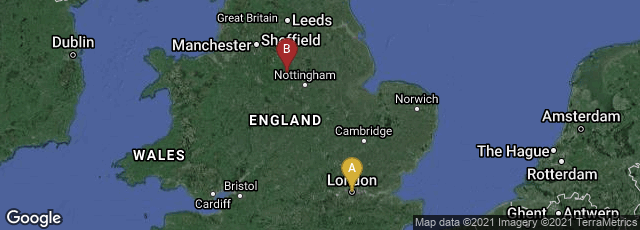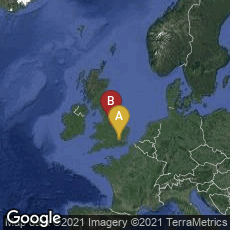My copy of this anonymous printed transcript bears the inscription of "Sykes and Taylor, Birkacre nearly Chorley." This was a cotton-spinning factory operated on a site owned by Richard Arkwright, or near a site owned by Arkwright, until 1779 when Arkwright's mill at Birkacre was destroyed by Luddite activity. According to the Grace's Guide website the Sykes and Taylor mill, which was water-powered, was sold at auction in 1788.


A: London, England, United Kingdom, B: Cromford, Matlock, England, United Kingdom
Richard Arkwright's extraordinary series of inventions and their commercial development necessarily resulted in opposition from other textile manufacturers. In 1781 Arkwright successfully sued nine firms for patent infringement, and in 1785 won a further case validating his 1775 patent. Arkwright's patents were so fundamental to the industry that by this time there were about 30,000 infringements, and out of necessity several manufacturers grouped together and obtained a writ of scire facias for a new trial to repeal the patent. The trial, which did invalidate the patent, resulted in a printed transcript as follows:
The trial of a cause, instituted by Richard Pepper Arden, Esq; his Majesty's Attorney General, by Writ of Scire Fascias, to repeal a patent granted on the Sixteenth of December 1775, to Mr. Richard Arkwright, for an invention of certain instruments and machines for preparing silk, cotton, flax, and wool for spinning; before the Honorable Francis Buller, one of the judges of his Majesty’s Court of King’s Bench,at Westminster Hall, on Saturday the 25th June 1785. London: Hughes and Walsh, Inner Temple Lane, 1785.
The trial hinged on the necessity to overturn Arkwright's claim to be the inventor of each separate machine. To give evidence a procession of millwrights, frame-makers, mechanics, smiths, and manufacturers, some who had been employed by Arkwright, came forward. They included the widow and son of James Hargreaves, inventor of the spinning jenny, but the central witnesses were John Kay, a watchmaker who had worked closely with Arkwright and had made models for him, and Thomas Highs, who claimed to be the real creator of the roller drawing process.
My copy of this anonymous printed transcript with its large folding plate of the device detailed in Arkwright's 1775 patent is of particular interest since on the final leaf it bears the inscription of "Sykes and Taylor, Birkacre nearly Chorley." This was a cotton-spinning factory operated on a site owned by Richard Arkwright, or near a site owned by Arkwright, until 1788. In October 1779 Arkwright's mill at Birkacre was destroyed by Luddite activity. According to the Grace's Guide website the Sykes and Taylor mill, which was water-powered, was sold at auction in 1788.
As a result of the invalidation of Arkwright's patent the cotton industry expanded rapidly in England, and Lancashire eventually superceded Arkwright's native Derbyshire as the center of cotton weaving.